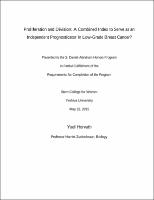Please use this identifier to cite or link to this item:
https://hdl.handle.net/20.500.12202/4248Full metadata record
| DC Field | Value | Language |
|---|---|---|
| dc.contributor.author | Horvath, Yael | - |
| dc.date.accessioned | 2018-11-14T20:41:30Z | - |
| dc.date.available | 2018-11-14T20:41:30Z | - |
| dc.date.issued | 2015-05 | - |
| dc.identifier.uri | https://hdl.handle.net/20.500.12202/4248 | - |
| dc.identifier.uri | https://ezproxy.yu.edu/login?url=https://repository.yu.edu/handle/20.500.12202/4248 | |
| dc.description | The file is restricted for YU community access only. | - |
| dc.description.abstract | According to the American Cancer Society, breast cancer is one of the most pervasive and deadly cancers to afflict women, killing approximately 40,000 women a year in the United States alone. One out of eight women will be diagnosed with breast cancer in her lifetime, and one out of thirty-six affected women will die. Patients with low-grade breast tumors; i.e., tumors consisting of cells that are close to normal, have the best chance of surviving and ultimately overcoming breast cancer. However, appropriate treatment for these patients is complicated because the tumors involved do not reproduce at the same rate. Cell reproduction can be considered from two different aspects; proliferation vs division. Each one is part of the cell cycle. A cell is considered to be proliferating if it has entered the cell cycle; it is no longer quiescent. A marker, Ki67, can distinguish those cells that are in the cycle. On the other hand, a cell is actually dividing only if it is in the M (mitosis) phase of the cycle, which occupies a short time span of the entire cycle. Though many hospitals rely on Ki67 counts to determine a patient’s prognosis rather than using mitotic counts, both Ki67 indexing and MI (mitotic indexing) are essential for estimating a patient’s overall prognosis and probability for survival. The Ki67 score relates to the potential for a tumor to metastasize, and the MI correlates to its active division. Therefore, the question is not whether to choose one system over the other, but rather how to marry the systems into a new risk index so that quantification of low-grade breast cancer risk can be more effectively assessed and ultimately provide for personalized therapy plans. | en_US |
| dc.description.sponsorship | S. Daniel Abraham Honors Program | en_US |
| dc.language.iso | en_US | en_US |
| dc.publisher | Stern College for Women | en_US |
| dc.rights | Attribution-NonCommercial-NoDerivs 3.0 United States | * |
| dc.rights.uri | http://creativecommons.org/licenses/by-nc-nd/3.0/us/ | * |
| dc.subject | Breast --Cancer --Diagnosis. | en_US |
| dc.subject | Breast --Cancer --Prognosis. | en_US |
| dc.subject | Breast --Cancer --Molecular diagnosis. | en_US |
| dc.subject | Cancer cells --Growth. | en_US |
| dc.subject | Tumor markers. | en_US |
| dc.subject | Cell cycle. | en_US |
| dc.subject | Medical screening --Evaluation. | en_US |
| dc.title | Proliferation and Division: A Combined Index to Serve as an Independent Prognosticator in Low-Grade Breast Cancer? | en_US |
| dc.type | Thesis | en_US |
| Appears in Collections: | S. Daniel Abraham Honors Student Theses | |
Files in This Item:
| File | Description | Size | Format | |
|---|---|---|---|---|
| Yael-Horvath.pdf Restricted Access | 702.75 kB | Adobe PDF |  View/Open |
This item is licensed under a Creative Commons License

